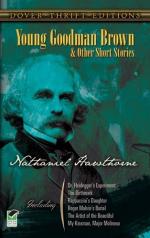|
This section contains 1,671 words (approx. 6 pages at 300 words per page) |

|
SOURCE: “‘Young Goodman Brown’: Hawthorne's ‘Devil in Manuscript’:—A Rebuttal,” in Studies in Short Fiction, Vol. 19, No. 4, Fall, 1982, pp. 381-84.
In the following essay, Hollinger presents a rebuttal to James L. Williamson's 1981 essay (see above) on “Young Goodman Brown,” arguing that the narrator is not “of the devil's party,” but someone who exposes the hypocrisy of Puritan New England society.
James L. Williamson's “‘Young Goodman Brown’: Hawthorne's ‘Devil In Manuscript’” identifies Hawthorne's tale as a “hell-fired” satire in which the speaker in the course of his telling the story “shows himself to be of the devil's party” and expresses a “demonic delight” in narrating a satanic tale, a delight that establishes him as the counterpart of the work's other devil figures, yet a close analysis of the narrative perspective in “Young Goodman Brown” shows its speaker to maintain a substantial distance from all of the characters in the...
|
This section contains 1,671 words (approx. 6 pages at 300 words per page) |

|


